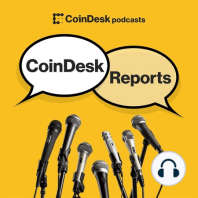48 min listen
MONEY REIMAGINED: Money Is a Meme, w/ Lana Swartz and Nicky Enright
FromCoinDesk Reports
ratings:
Length:
63 minutes
Released:
Sep 25, 2020
Format:
Podcast episode
Description
Money is changing, but where do we go from here? Through high profile interviews and thoughtful analysis, join CoinDesk's Michael Casey and Sheila Warren of the World Economic Forum as they explore the connections between finance, human culture and our increasingly digital lives.In this inaugural episode media studies professor Lana Swartz and multimedia artist Nicky Enright join the discussion.Sushi, Hotdogs, Yams, Shrimp. The whimsical, food-obsessed names of DeFi protocols are antithetical to the stodgy imagery of the mainstream financial system they seek to disrupt. Banks’ memes, by contrast, skew toward strength and durability. (Think of the rampart lions and Roman columns at the entrances of bank branches in old parts of London, New York or Paris.)DeFi’s critics say the silly names betray the fact it’s merely a fad and a game – or worse, a scam. It’s all imaginary, they say. It’s not real. The problem with that perspective is that all aspects of money, including the financial systems built on top of it, are imaginary. And, in case you’re wondering, that’s a feature, not a bug. Israeli historian Yuval Harari calls money “the most successful story ever told,” even more important to the evolution of society than religion, corporations and a host of other human-imagined institutions. Like those concepts, money’s power hinges on the collective adoption of a common belief system. It takes a set of mutually understood rules and gives them symbolic representation in a token we call a currency. In exchanging that token, we reach agreements that reflect those rules and so enable commerce, collaboration, value creation and, ultimately, civilization. Storytelling and cultural creation have always been integral to how society fosters this belief system, how we’ve forged communities around currencies. It’s why representations of money and the conversations around it are rich with iconography, foundational myths and stirring language.This process of collective imagination has become firmly tied to another powerful imaginary concept: the nation-state. This combination has been so effective that it has survived the introduction of new technologies and tokens over time. We’ve gone from shells to coins to banknotes to checks to credit cards to Venmo, and each time we’ve just accepted that a new transfer vehicle can convey the same rules and values we’ve always attached to our national currencies. This is a useful lens to apply to the many new ideas for money bubbling up in the crypto world. Whether it’s bitcoin’s bid to become a digital gold-like currency or the fight between Uniswap and SushiSwap to dominate liquidity in DeFi’s lending markets, the semiotic process for creating memes and stories is vital to the establishment of a new system. National elites used such methods to get us to collectively imagine a bank-centric system of fiat currencies. Those of us who want to change that need to do something similar. We need to reimagine money.Imagined CommunitiesIf you have a $100 bill in your wallet, take a good look at it.On one side, there’s Ben Franklin’s balding head and torso, behind which are a quill, an inkwell with the Liberty Bell superimposed onto it, and an extract from the Declaration of Independence. There are also the seals of the U.S. Treasury and the Federal Reserve, the signatures of the Secretary of the Treasury and the Treasurer, a serial number and other identifying numerals. On the other, we see Independence Hall in Philadelphia, where Franklin and other Founding Fathers signed the declaration, along with the words “In God We Trust.” On both sides, the number 100 appears numerous times in and around a highly ornate border. Combined with cotton threads and watermarks, the baroque design helps make the note difficult to counterfeit. But more importantly, the imagery appeals directly to patriotism. It’s all associated with the nation-state to which the dollar, we are encouraged to believe, is indelibly linked. Now think
Released:
Sep 25, 2020
Format:
Podcast episode
Titles in the series (100)
MONEY REIMAGINED: Understanding Bitcoin and Stablecoins in Africa and South America by CoinDesk Reports
